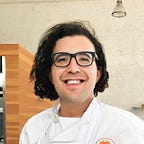Culinary Externship, Finale: Prep Cooking
For my last week working at Prospect, a fine-dining restaurant in San Francisco, I was a “prep cook”. I prepared multi-hour cooking projects like steaming dumpling, rolling out pasta dough, shaping Falafel, making Arancini, and so on. Line cooks mostly take recipes that have an “active time” of less then 15 minutes where as a prep cook I really got to stay with the large scale recipes for hours.
Traditionally I’ve made pasta dough with a fork and two egg yolks. Making pasta dough at the restaurant is a much larger production involving 150 egg yolks and an 80qt human-sized Hobart Mixer.
How to make pasta dough in a Hobart Mixer: add all wet ingredients. Add 50% of dry ingredients and run on lowest speed until mostly combined (1–2m). Add remaining 25% on lowest speed until combined; repeat. Let Hobart Mixer run for 6–8m until pasta dough is ready.
After making 10kg of yellow pasta dough, I also made 10kg of Squid Ink Pasta Dough. The aforementioned process of large scale pasta dough production stays the same even shen the ingredients and final shape change.
What was the difference between Yellow Pasta Dough and Squid Ink Pasta Dough at the restaurant? Yellow dough has a 1:1 egg yolk : pastry flour which makes it super rich & supple. Squid Ink pasta dough felt much rough to the touch. Squid Ink pasta used 2:1 ratio of dry:wet ingredients; the dry ingredients were durum & semolina; and half of the wet ingredients was just simple water and no fat. Overall, squid ink pasta turned out much more rustic than yellow pasta dough.
“Tomato Water” is the liquid extract from tomatoes and it’s used in several recipes in the restaurant. In the restaurant whenever we cut out tomatoes we keep the trimmings and make them into tomato water. The resulting clear orange-tinted liquid is super flavourful.
How to extract tomato water: Take tomato trimmings, vitemix them until liquidy and strain overnight. To strain I took a 4" deep hotel pan with a 2" deep perforated hotel pan, lined with cheese cloth and let strain naturally overnight. Reading up on tomato water there’s plenty of other ways of extracting tomato water.
These Shumai Shrimp Dumplings are steamed and served with homemade Sichuan Sauce. I really love the filling for these because it screams “seafood”.
What’s in the filling for these Shrimp Dumpling? The filling is 90% a combination of diced shrimp and finely blended scallops. Everything is mixed in with sliced shiitake, halibut stock, egg whites, ginger, kombu reduction, yuzu, cilantro, salt, etc. The interesting thing is that by weight most of the dumpling filling is actually just finely blended scallop and diced shrimp.
These Truffle Arancini are so decadent. I thought knew all deep-fried coatings since last year I learned the difference between “dredging”, “battering” and “breading”. The restaurant has a different “breading” process then any of those and it made a huge difference.
How to bread food prior to deep-drying at Prospect Restaurant: first, roll in rice flour. Then dip in egg whites. And finally roll in blended breadcrumbs. All these small changes from what I’m used to really make a difference. e.g. Using rice flour and not AP flour; and using egg whites and not whole egg; and blending the breadcrumbs first.
It’s interesting that to make these potato cakes we used Potatoes that were oven roasted only halfway until they were fully cooked. To make these Potato Cakes we grated half-cooked potatoes, mixed in a bit of potato starch and salt, shaped them and deep-fried.
The last recipe I made at Prospect Restaurant on my last day were the bar olives. It’s a simple recipe that makes for beautiful photography. This recipe mixes three different kinds of olives, lemon peel, chili flakes, bay leafs, thyme and EVOO. The whole thing is then vacuum sealed and marinades itself.
The thing you don’t see is the Adobe Lightroom Photo Editing I do before each of these posts. Colours are saturated, light scrape is balanced, borders are sharpened and much more. It’s a manual zen-like process I’ve learned to love.
Read more about my culinary adventures by reading about my previous week at Prospect working the pastry station:
